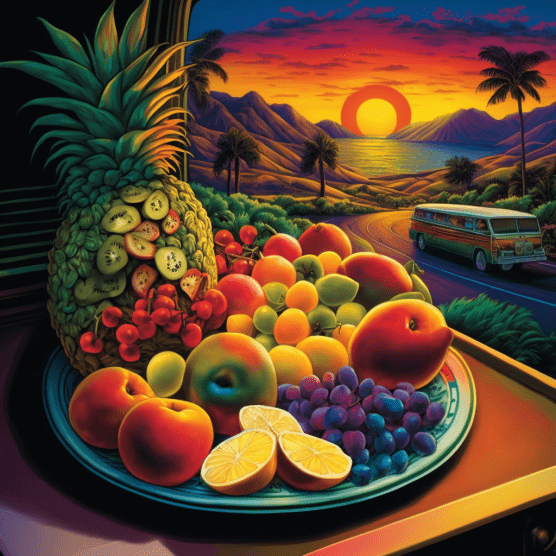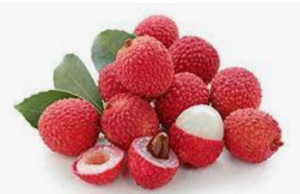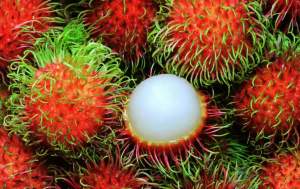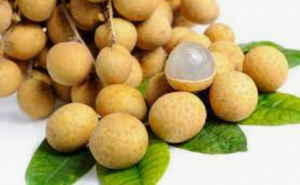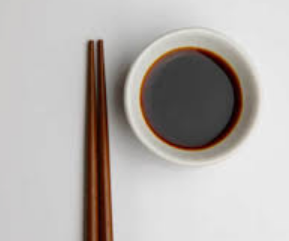Present Hawai’ian Island food culture is a melting pot of many international influences. You’ve got Portuguese, Native Hawai’ian cuisine, American, Chinese, Filipino, Japanese, Korean and Polynesian sometimes all rolled into one meal!
When you put all of these food cultures into an equation, the results are infinite and nothing less than unique and creative!
Ultimate Guide To Hawai’ian Islands Local Foods Desserts and Sweets
Let’s start with dessert items shall we, because who doesn’t love dessert?
Shave Ice – Shave ice or Hawaiian shave ice is an ice-based dessert made by shaving a block of ice. To be correct, it’s ‘Shave Ice’ not Shaved Ice! While the product can resemble a snow cone, snow cones are made with crushed, rather than shaved, ice. Served in a cone or cone shaped cup, flavored syrups are added to the ice, which are absorbed by the ice instead of surrounding it, shave ice in Hawai’i is often flavored with local ingredients such as guava, pineapple, coconut cream, passion fruit, li hing mui (salty dried plum), lychee, kiwi fruit and mango. The toppings are very unique to Hawai’i too! Look for mochi balls, sweetened condensed milk, adzuki beans, ice cream! You won’t find toppings like shredded toasted coconut or adzuki beans on the Mainland!
Haupia – Haupia is a traditional coconut milk-based Hawai’ian dessert often found at luaus and other local gatherings in Hawaiʻi. Think of it as coconut finger jello. The traditional Hawaiian recipe for haupia calls for heated coconut milk to be mixed with ground pia (Polynesian arrowroot, Tacca leontopetaloides) until the mixture thickens. Due to the lack of availability of arrowroot starch, some modern recipes for haupia substitute cornstarch. Don’t worry if you fall in love with Haupia while visiting the Island, you can buy packets at the local grocery stores and take it home with you or order online too! But it’s also simple enough to make from scratch at home.
Portuguese Sweet Bread – or Pao Doce, that was originally a Christmas and Easter tradition. Portuguese sweet bread is a bread made with milk, sugar and/or honey, eggs, yeast, flour and sometimes lemon peel to produce a subtly sweet lightly textured loaf or rolls. If you’ve ever found ‘King’s Hawai’ian Bread’ on the mainland you get an idea of what this yummy bakery goodie is all about.
Kulolo – Kulolo is a Hawai’ian dessert made primarily with baked or steamed grated taro corms and either with grated coconut meat or coconut milk. Considered a pudding, kulolo has a solid consistency like fudge and is often served cut into squares.
Malasada – Hawaii’s favorite fried treat. A malasada is a Portuguese confection, made of egg-sized balls of yeast dough that are deep-fried in oil and coated with granulated sugar. Think Mainland donut holes on steroids. There’s an upcoming blog post that I’ll do on the divine Malasadas from the Sugar Beach Bake Shop. Suffice it to say that they are amazing – and all Malasadas are not created equally!
Mochi Ice Cream – Mochi Ice Cream is bite-sized ice cream wrapped in mochi, a sweetened rice dough. Pretty much anything Mochi, not just Mochi Ice Cream is popular in Hawaii. Why not try Butter Mochi, or Mochi Balls on your Shave Ice or Mochi’s cousin Chi Chi Dango (another confection made from rice flour).
Fruits
Lychee (always choose lychee that are as red as possible. Redder is better!)
Fresh lychee can usually be found in Asian markets. Underneath the hard, bumpy husk is tender, white flesh with a sweet strawberry-watermelon flavor that covers an inedible stone, which is the fruit’s seed. Lychee is eaten raw on its own.
Rambutans (as with lychee, (always choose rambutans that are as red as possible. Redder is better!). Visually, they have a bizarre, hairy exterior that conceals a smooth, sweet white fruit within. Even with its thicker skin (than a lychee) you can easily peel open a rambutan by splitting the skin apart with your nails and spreading it back, much as you would peel an orange. Don’t worry about the spines; they look sharp but are actually quite soft and bend back easily.
Longan fruit is very juicy, mostly water, and high in natural sugar content, so it is very sweet. The translucent flesh has the consistency of a grape and it also taste grape-like. There are tropical flavors as well, with a hint of muskiness/funk. But the musk flavor isn’t unpleasant.
Snacks
Technically speaking many of the items listed here could fall under the snack category but here are a few that are specifically – just snacks.
Crack Seed – Crack seed is a category of snacks that originated in China. It is highly popular in many regions, such as Hawaii. Crack seed are basically preserved fruits that have been cracked or split with the seed or kernel partially exposed as a flavor enhancement. The flavors are varied, ranging from extremely sweet and salty to sour flavors. Flavors can include rock salt plum, li hing mui, honey mango, licorice peach, or any kind of combination of fruits, flavors and type of preservatives used. What originally was a preserved fruit has become a favorite snack in Hawaii and a sample of a cultural food.
Li Hing Mui – Basically a salted, dried plum but also a flavoring. You can find variations such as seedless, shredded, sweet, sweet-sour, red, white etc. Eaten as a snack , Li Hing for short, is a a ‘crack seed’. But the flavoring – which is ground up plum skin mixed with various other flavors and red color – is sprinkled on fresh fruit, added to tropical drinks, shave ice, you name it. An acquired taste for most and the ingredients of present day Li Hing Mui don’t exactly convey as ‘health food’ (think red and yellow food dye with aspartame).
Taro Chips – One of my favorite snacks (and I like to start my trip to Maui eating them on the plane, Hawaiian Airlines currently offers them on their snack menu.) The Hawaiian Chip Co. makes (in my opinion) the best taro chips. They are not overly salted like ones from another major chip company. They’re just perfect for snacking on the beach! I love their starchy goodness and rarely do I not eat an entire bag.
Have you gone into a sugar coma yet? Mouth puckering from the thought of sour pickled plums? Yea, me too. Let’s move on to some main dishes shall we.
And speaking of Taro, let’s talk about…
Poi – I recall stories from my Tutu (grandmother) of my mom eating fresh poi as a baby during the years they lived on Oahu. I’ve eaten poi several times, but it’s been a while. Note to self; eat poi again on next trip to Maui! According to Wikipedia (and I use their reference to make sure I get it right).
Poi is a Hawaiian word for the primary Polynesian staple food made from the underground plant stem or corm of the taro plant (known in Hawaiian as kalo). It is a traditional part of Native Hawaiian cuisine.
Poi is produced by mashing the cooked corm (baked or steamed) until it is a highly viscous fluid. Water is added during mashing and again just before eating to achieve the desired consistency, which can range from liquid to dough-like. As such, poi can be known as “one-finger,” “two-finger,” or “three-finger” poi depending on the consistency, alluding to how many fingers are required to scoop it up in order to eat it (the thicker the poi, the fewer fingers required to scoop a sufficient mouthful). Poi can be eaten immediately when fresh and sweet, or left a bit longer to ferment.
For me, poi was a bit like the kindergarten paste of my childhood in texture, not that I ate paste as a kid, has a mild flavor and would be a staple that I imagine is like growing up with hot oatmeal for breakfast.
Main Dishes
Loco Moco – This is some kind of meal and how it came to be is a bit of a mystery to me as the combination is not one I’d ever come up with (the history of this local and widely popular dish is known and is said to have come from Lincoln Grill in Hilo). Imagine this, a plate of white rice topped with a hamburger patty, then smothered in gravy/sauce and finished off with an over-easy fried egg. There are of course variants to this dish but generally speaking these are the ‘bones’ of it.
Manapua – Manapua is a Cantonese barbecue-pork-filled bun (Cha siu bao). In Hawai’i, Manapua’s name is a shortening of the Hawai’ian mea ʻono puaʻa, meaning, “delicious pork thing.” This Dim Sum item consists of a white bun with a dark pink-colored diced pork filling. Manapua has come to mean any meat-filled or bean-paste-filled bun made with the same dough and includes locally created versions with hot dogs, curry chicken, kalua pig, and even ube (purple yam), which is a popular vegetarian version of the manapua. In Hawai’i, freshly prepared or prepackaged frozen manapua may be found in dedicated bakeries, restaurants, food trucks, swap meet vendors and chain convenience stores. Which side of the fence you reside on, steamed or baked will provide you with endless debate among locals.
Mixed Plate/Plate Lunch – typical plate lunch consists of white rice, macaroni salad (more on that later), and a meat of your choosing, such as pork, lau lau (more on that later too) maybe mahi mahi, katsu chicken or teriyaki beef. “The best plate lunches are simple, unassuming meals made in small, non-franchise, hole-in-the-wall, joints owned by local and ethnic families for generations.” says Amberloo of TripAdvisor. When ordering, if your server asks “toss or mac” – you’re being asked if you tossed salad or macaroni salad. Plate lunch purists usually expect both white rice (although brown rice is now often available) and “mac salad.”
Spam Musubi – Spam is an immensely popular item in Hawaii. Go figure. And when you look at the quintessential island-fusion fast-food item, well… you get Spam Musubi. What the heck is it you say? It’s the ultimate portable snack or lunch food on the islands and is as ubiquitous as flip flops and sunscreen here. A hunk of fried/grilled spam sits atop a block of white rice wrapped in nori in the tradition of Japanese omusubi.
Macaroni Salad – Not a fan here, but if you are then you’re in the right spot if you’re in Hawai’i! This ubiquitous pasta salad, nearly always served via ice cream scoop is accompanied by a same-shaped scoop of white rice (or two) and just about every place has it on the menu.
Plate Lunch Special
Saimin – Probably the ultimate local comfort food. Saimin (rhymes with eye-bin) is Chinese in origin but has blended over the years to be truly unique to the Islands. According to Hawai’i Magazine “One of Hawai’i’s most traditional local foods, saimin is an iteration of a Chinese egg-noodle soup that was developed during the Islands’ plantation era. You can taste how the recipe has been touched by Hawai‘i history’s different immigrant groups, primarily the thin Chinese chow mein-inspired noodles wading in a Japanese dashi broth. As more migrations followed, more ingredients informally entered the mix—green onions, kamaboko, kimchi, Portuguese sausage, Spam—to create the recognizable bowls of saimin you see today. It’s become so iconic you can order it at sporting events at Aloha Stadium, even McDonald’s locations across Hawaii. Star Noodle on Maui is one of the island’s go-to saimin shops.“
Poke – It’s not sushi, it’s poke. And it’s pronounced PO-keh! Many pronounce it like ‘Pokey’ as in ‘Do the Hokey Pokey‘ but the sure fire way to blend in while traveling in Hawai’i is to pronounce it correctly. Most often Poke is made from Ahi (yellowfin tuna), shoyu sauce (we say shoyu in Hawai’i, the mainland says ‘Soy Sauce’), onions, and any number of other flavors like sesame oil, avocado, seaweed, Sriracha and more. Our favorite Poke comes from Domo in Honolulu’s Chinatown, or one of the many Foodland grocery stores, but is truly available all over our beautiful island nation of Hawaii. If you’re not sure if you’d like poke or not, just ask for a free sample to try.
Shoyu – As mentioned above, in Hawai’i we call soy sauce by the name ‘Shoyu’ and it’s as much a staple as ketchup and mustard on the mainland. So though Shoyu isn’t unique to the Islands, but what we call it is really a regional thing. Wanna sound ‘local’, don’t ask for soy sauce. Just ask for “shoyu.”
Eat Something Delicious Today,
Matthew Gray
Hawaii Food Tours®
CFG {Chief Food Guy}
www.HawaiiFoodTours.com
8 0 8 . 389 . 8255
Tasty Tours for the Hungry Traveler
[/et_pb_text][/et_pb_column] [/et_pb_row] [/et_pb_section]